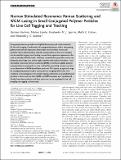Narrow stimulated resonance Raman scattering and WGM lasing in small conjugated polymer particles for live cell tagging and tracking
Abstract
Conjugated polymer particles are brightly fluorescing and stable materials for live cell imaging. Combination of conjugated polymers with a whispering gallery mode (WGM) resonator allows laser emission from microscale particles. Once internalized by cells, the mode pattern of the laser emission can be used for tagging and tracking, as each laser spectrum represents a bar code to identify individual cells. However, currently these particle systems are limited by their large size, which might interfere with cellular functions. Here we present, stimulated resonance Raman scattering (SRRS) in small conjugated polymer microparticles as a new method for generating narrow emission as an alternative to WGM-based laser emission. This opens up spectral range for multiplexing optical readout and multicolor imaging of live cells. We discuss the synthesis of monodisperse micron-sized poly(fluorene-co-divinylbenzene) particles and characterize their WGM and SRRS emission. Finally, we showcase how these particles and their emission can be employed in live cell imaging and tagging.
Citation
Haehnle , B , Lamla, M , Sparrer, K M J , Gather , M C & Kuehne , A J C 2020 , ' Narrow stimulated resonance Raman scattering and WGM lasing in small conjugated polymer particles for live cell tagging and tracking ' , Advanced Optical Materials , vol. Early View , 2001553 . https://doi.org/10.1002/adom.202001553
Publication
Advanced Optical Materials
Status
Peer reviewed
ISSN
2195-1071Type
Journal article
Description
The authors thank the Deutsche Forschungsgemeinschaft (DFG) for funding this research (grant no. KU 2738/3-2). KMJS is supported by the German Federal Ministry of Education and Research (IMMUNOMOD research group, 01KI2014). M.C.G. acknowledges financial support from the European Research Council under the European Union’s Horizon 2020 Framework Programme (ERC StG ABLASE, 640012) and from the Alexander von Humboldt Stiftung (Humboldt-Professorship).Collections
Items in the St Andrews Research Repository are protected by copyright, with all rights reserved, unless otherwise indicated.

